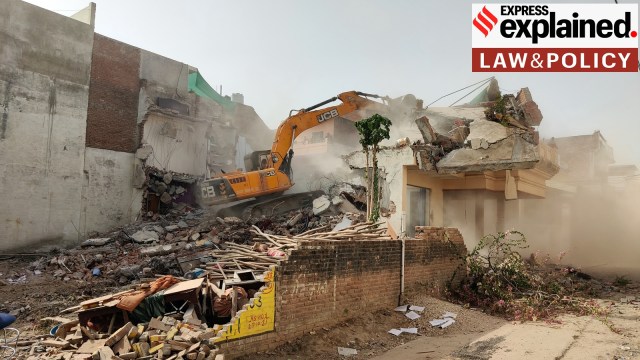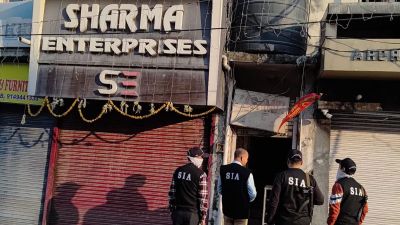What Supreme Court said about ‘bulldozer justice’ in its verdict
Highlighting the importance of public officials being held accountable, the Supreme Court laid down guidelines to curb illegal demolition of the homes of persons accused in criminal cases. Here are the details.
 A bulldozer demolishes the house of an activist accused of being involved in violent protests in Prayagraj, Uttar Pradesh, in 2022. (Express photo by Ritesh Shukla)
A bulldozer demolishes the house of an activist accused of being involved in violent protests in Prayagraj, Uttar Pradesh, in 2022. (Express photo by Ritesh Shukla)The Supreme Court on Wednesday laid down a series of guidelines to ensure that due process is followed for demolishing the properties of citizens.
These guidelines were a part of the court’s verdict in a case that had raised the issue of demolition of properties by state authorities as a punishment for the alleged involvement of the property owner in a crime. The case was heard by a Bench of Justices B R Gavai and K V Viswanathan.
The verdict came just days after then Chief Justice of India D Y Chandrachud, while hearing a case regarding a man whose home was illegally demolished by the UP government as a part of a road widening project, referred to such demolitions “bulldozer justice”.
What was the case?
The case pertained to a set of pleas that challenged the “extra-legal” practice of demolishing houses of people accused of criminal activities. The practice has been observed in recent years in BJP-ruled states such as Uttar Pradesh, Madhya Pradesh, and Uttarakhand. It was also seen in Rajasthan, during Congress rule in 2022.
Wednesday’s ruling was prompted by incidents in Udaipur, Rajasthan, and Ratlam, MP, earlier this year.
In Ratlam, bulldozers were used to pull down a family’s ancestral home after the owner’s son was arrested for slaughtering a cow in June. In Udaipur, the municipal corporation demolished a tenant’s house for allegedly “encroaching” on forest land. The demolition took place in August soon after the tenant’s 15-year-old son was arrested for stabbing his classmate from another community, leading to a flare-up in communal tensions in the city. The lawyers submitted that the demolition and the accusations against the tenant’s son were connected.
These pleas were tagged with another set of cases which pertained to demolition drives in other states.
One of them was filed by the Jamiat-Ulama-i-Hind in April 2022 amidst a demolition drive that followed communal violence in Delhi’s Jahangirpuri.
What are the guidelines?
The guidelines laid down by the SC place emphasis on transparency and giving the accused and their family sufficient time to handle their affairs. The SC clarified that the guidelines will not apply to “an unauthorised structure in any public place such as road, street, footpath, abutting railway line or any river body or water bodies and also to cases where there is an order for demolition made by a Court of law”.
PROVIDING NOTICE: The SC said a minimum of 15 days prior notice must be given for a person to respond to before demolition is carried out, starting from the date that the owner or the occupier receives the notice. This notice must contain details of the structure, why it is being demolished, and a date for a “personal hearing” to allow owners to contest the demolition.
As soon as the notice is served, the local Collector or the District Magistrate should be informed via email, with an arrangement for an auto-reply acknowledgment of the email’s receipt “[t]o prevent any allegation of backdating”, the SC said.
HEARING & FINAL ORDER: After conducting a hearing where the minutes are properly recorded, the SC said the final order must mandatorily contain certain information. This includes the arguments made by the owner or the occupier, why the authority (such as the local municipal corporation) believes the case cannot be settled, and whether the entire construction or only a part is to be demolished. Reasons such as “why the extreme step of demolition is the only option available” should also be mentioned, the SC said.
THE AFTERMATH: If the authority passes a final order for demolition, and after the property owner or the occupier receives the order, the SC said, “the order will not be implemented for a period of 15 days”. This allows the owner or the occupier to either remove the construction or challenge the final order in court and seek a stay order.
At the end of this second 15-day period, if the final demolition order has not been stayed and the construction has not been removed, demolition can be carried out. However, the authority must take a video recording of the demolition and prepare both an “inspection report” before the demolition and a “demolition report” with a list of personnel involved in the demolition process.
What is the SC’s reasoning for the guidelines?
The SC relied on several fundamental constitutional and legal principles that are violated when the illegal demolition of an accused person’s property takes place.
SEPARATION OF POWERS: The verdict stresses that the judiciary is entrusted with “adjudicatory” (decision-making) powers to decide if an accused person is guilty, and whether any of the organs of the state have “transgressed” their limits. The judiciary then asks, “Can the officers of the State Government take upon themselves the adjudicatory function and without a person undergoing a trial be inflicted with a punishment of demolition of his properties.”
It would be “wholly impermissible” for the state to decide that demolition can be a punishment for an accused person, according to the SC. It said, “The executive cannot replace the judiciary in performing its core functions”.
PUBLIC TRUST & TRANSPARENCY: The SC said public officials must be held accountable for both their actions and inactions. Officials who “take the law in their hands” and pass demolition orders on the ground that the owner or occupier of the property is an accused “should be made accountable for such high-handed actions,” according to the court.
The SC also said the guidelines are necessary to ensure that the government acts in a “transparent” manner and hold them accountable when they don’t.
RIGHT TO SHELTER: The SC noted that the accused is not the only one who lives or owns such properties. It highlighted that the right to life with dignity under Article 21 of the Constitution includes the right to shelter. Depriving this right of the other innocent people living in the same house as the accused would be “wholly unconstitutional”, according to the SC.
To address cases where the demolished property houses an accused but also violates municipal laws as an illegal construction, the SC laid down a separate test. It said when a “particular structure is chosen all of a sudden for demolition and the rest of the similarly situated structures in the same vicinity are not even being touched” it can be presumed that the “real motive” was to penalise the accused and not to remove an illegal construction.





- 01
- 02
- 03
- 04
- 05


































